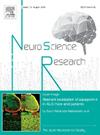In vivo recording from calcitonin receptor-expressing neurons in the medial preoptic area during affiliative social behaviors
IF 2.4
4区 医学
Q3 NEUROSCIENCES
引用次数: 0
Abstract
Social animals, including mice, are motivated to seek social contact and avoid being alone due to the benefit of the group living in survival and reproductive values. We have previously reported that pup exposure and co-housing with adult female mice can induce the expression of c-Fos in calcitonin receptor (Calcr) neurons located in the medial preoptic area (MPOA) of female mice. These neurons mediate maternal and social contact behaviors among adult virgin females. However, the correlation of the activity of MPOACalcr+ neurons with specific social behaviors remains unclear. In this study, we used in vivo fiber photometry to study MPOACalcr+ neuron activity during affiliative social behaviors. We found that MPOACalcr+ neurons are activated during proactive contact with adult female mice but not during passive contact, suggesting that motivation to seek social contacts is associated with the activation of these neurons. MPOACalcr+ neurons are not activated during contact with non-social objects, such as novel foods and nesting materials, supporting their specific involvement in social behavior. Furthermore, these neurons are more robustly activated during alloparental behaviors such as pup retrieval. Overall, this study demonstrates the involvement of MPOACalcr+ neurons in motivated social interactions with pups and peer females.
在亲和的社会行为中,来自内侧视前区表达降钙素受体的神经元的体内记录。
包括老鼠在内的群居动物,出于生存和繁殖价值的群体利益而寻求社会联系,避免孤独。我们之前报道过幼鼠暴露和与成年雌性小鼠共居可以诱导位于雌性小鼠内侧视前区(MPOA)的降钙素受体(Calcr)神经元中c-Fos的表达。这些神经元调节着处女成年雌性的母性和社会接触行为。然而,MPOACalcr+神经元的活性与特定社会行为的相关性尚不清楚。在这项研究中,我们使用体内纤维光度法研究了MPOACalcr+神经元在亲和社会行为中的活动。我们发现MPOACalcr+神经元在与成年雌性小鼠的主动接触中被激活,而在被动接触中则没有,这表明寻求社会接触的动机与这些神经元的激活有关。MPOACalcr+神经元在接触非社会性物体(如新食物和筑巢材料)时不被激活,这支持了它们对社会行为的特定参与。此外,这些神经元在异亲代行为中被更强烈地激活,比如找回幼仔。总的来说,这项研究表明MPOACalcr+神经元参与了与幼崽和同伴雌性的动机社会互动。
本文章由计算机程序翻译,如有差异,请以英文原文为准。
求助全文
约1分钟内获得全文
求助全文
来源期刊

Neuroscience Research
医学-神经科学
CiteScore
5.60
自引率
3.40%
发文量
136
审稿时长
28 days
期刊介绍:
The international journal publishing original full-length research articles, short communications, technical notes, and reviews on all aspects of neuroscience
Neuroscience Research is an international journal for high quality articles in all branches of neuroscience, from the molecular to the behavioral levels. The journal is published in collaboration with the Japan Neuroscience Society and is open to all contributors in the world.
 求助内容:
求助内容: 应助结果提醒方式:
应助结果提醒方式:


